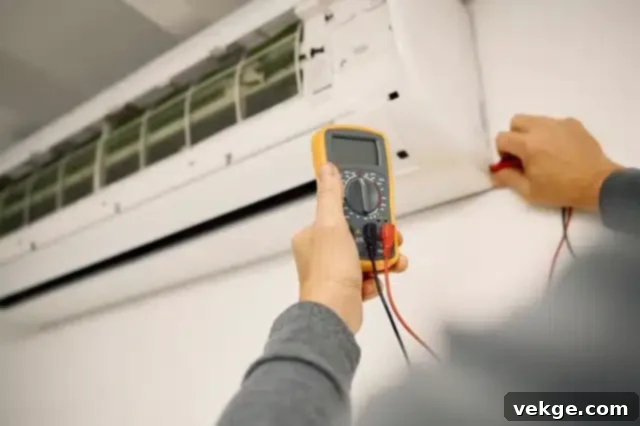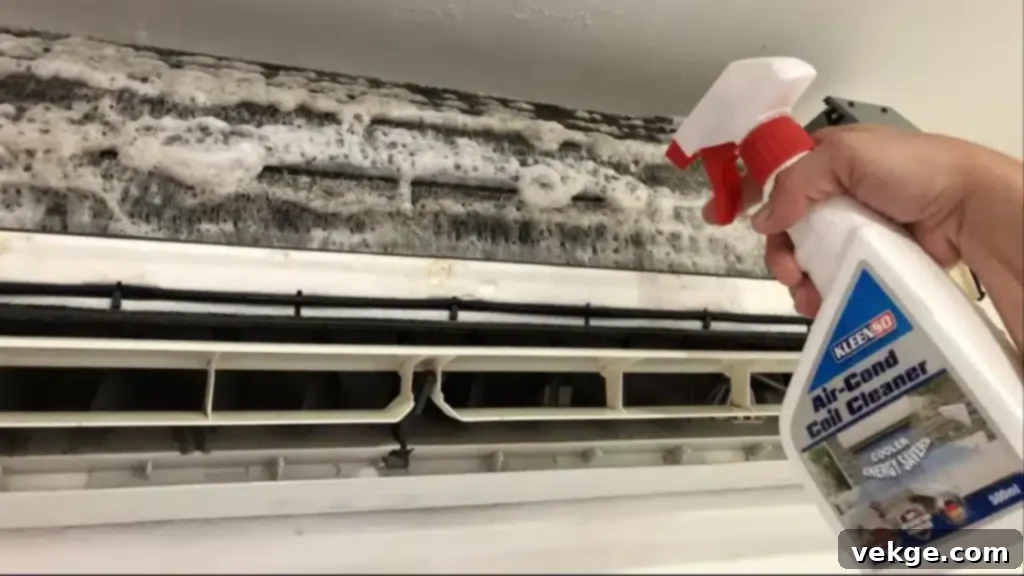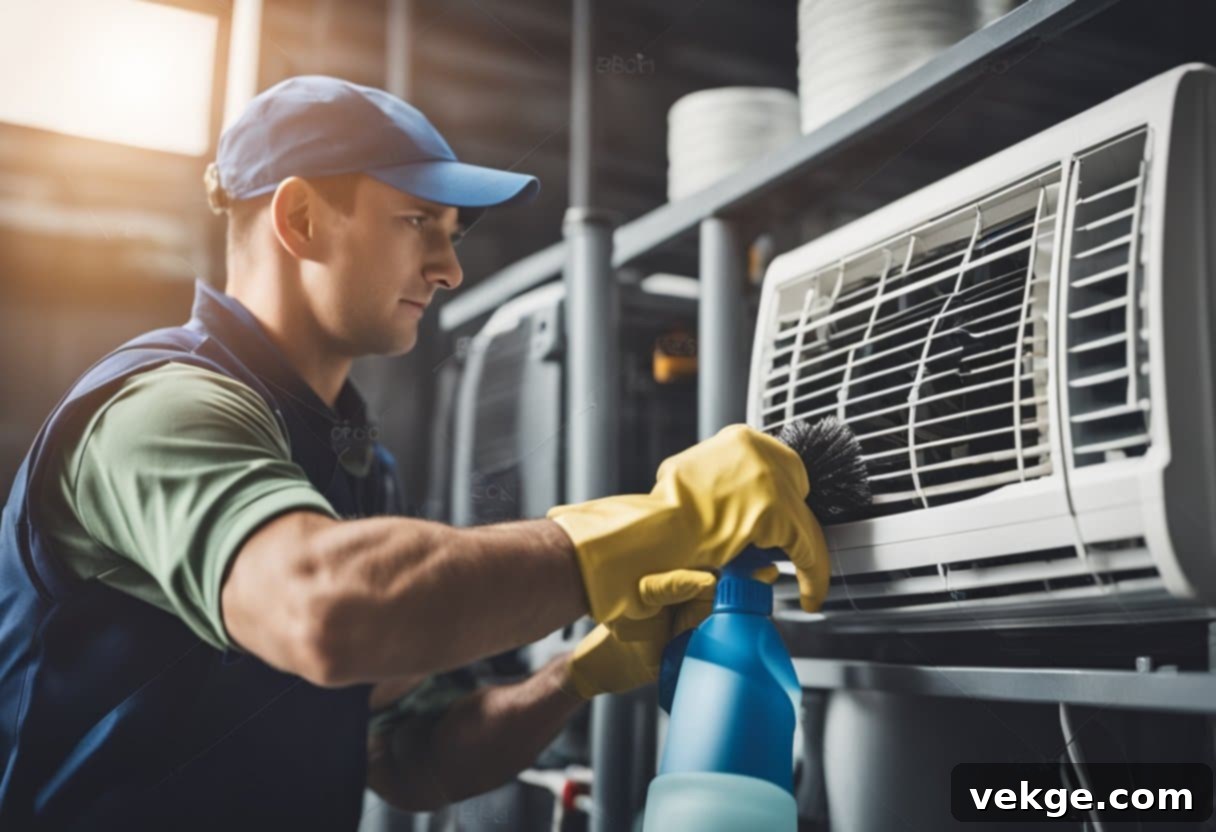The Ultimate Guide to AC Maintenance: How to Clean Your Air Conditioner for Optimal Efficiency & Longevity
Ensuring the longevity and peak performance of your air conditioning system is paramount for any homeowner. Far beyond just cooling your space, a well-maintained AC unit contributes significantly to your home’s energy efficiency, indoor air quality, and overall comfort. Experts universally recommend consistent air conditioner maintenance, including a thorough cleaning at least once a year, to prevent the common pitfalls of neglect: sky-high energy bills, frequent breakdowns, and costly repairs. This proactive approach not only keeps your home cool and comfortable but also extends the operational life of your valuable investment, saving you significant money in the long run.
Ignoring the critical task of cleaning your air conditioner can trigger a cascade of negative consequences. Over time, the internal components of your AC unit become a magnet for dirt, dust, pollen, pet dander, and other airborne debris. This accumulation forces your system to work exponentially harder to achieve and maintain your desired temperature, leading to a noticeable reduction in cooling efficiency and a regrettable surge in your monthly electricity bills. More than just an energy drain, a dirty AC can also compromise the air you breathe, circulating allergens and pollutants throughout your home. Regular, scheduled cleaning is therefore not just about efficiency; it’s about safeguarding your health and enhancing the holistic comfort of your living environment.
The optimal frequency for cleaning your air conditioner isn’t a one-size-fits-all answer; it’s a dynamic variable influenced by several factors unique to your household and geographical location. Homes situated in environments prone to high pollen counts, significant air pollution, or dusty conditions may necessitate more frequent cleaning interventions. Similarly, if your air conditioner operates tirelessly for extended periods, especially during scorching summer months or in climates where cooling is required year-round, its components will accumulate debris at a faster rate, demanding more rigorous and regular maintenance to sustain its high performance and reliability.
Understanding AC Maintenance: The Foundation of a Healthy Home Environment

The bedrock of an efficient and long-lasting air conditioning system lies in consistent and knowledgeable maintenance. Grasping both the profound importance of routine cleaning and establishing an effective frequency for your specific unit are key steps toward unlocking optimal performance, ensuring a comfortable indoor climate, and mitigating the risk of unexpected malfunctions. This section delves into the critical rationale behind regular AC care and guides you through determining the perfect cleaning schedule for your system.
Why Regular AC Cleaning is Non-Negotiable for Your Home
The benefits of keeping your air conditioner meticulously clean extend far beyond simple aesthetics. Primarily, regular cleaning ensures unimpeded airflow and allows your unit to operate with the efficiency it was designed for. Dust, debris, pet hair, and even microscopic particles of mold can rapidly accumulate within your system’s filters, evaporator coils, condenser coils, and ductwork. This accumulation acts as an insulating layer and a physical barrier, severely hindering heat exchange and restricting the volume of air that can pass through the unit. Consequently, the AC is forced to expend more energy to achieve the same cooling effect, directly translating into higher energy consumption and inflated utility bills.
Beyond the financial burden, dirty components create a fertile breeding ground for mold, mildew, bacteria, and other allergens. When your AC circulates air, these harmful microorganisms are distributed throughout your home, significantly compromising indoor air quality. This can exacerbate allergies, asthma, and other respiratory issues for occupants, transforming your home from a sanctuary into a source of discomfort. Proactive cleaning helps to prevent these health hazards, ensuring the air you breathe is clean and fresh. Moreover, neglecting maintenance places undue strain on critical components like the compressor and fan motor, accelerating wear and tear. This not only shortens the overall lifespan of your expensive AC unit but also dramatically increases the likelihood of frequent breakdowns and costly repairs, often negating any perceived savings from skipping routine care. Adhering to a maintenance schedule can also keep your AC Maintenance and Repair costs manageable and predictable.
Crafting Your Ideal AC Cleaning Schedule: Factors to Consider
Determining the optimal frequency for cleaning your air conditioner is a personalized process, influenced by a blend of environmental, usage, and structural factors. While general guidelines exist, tailoring your schedule ensures maximum efficiency and longevity for your specific unit. For most residential units that see daily use during the cooling season, a basic cleaning of the air filters once a month is not just advisable, but often essential. These filters are the first line of defense against airborne contaminants and can become clogged very quickly, especially in homes with pets, smokers, or individuals with allergies.
The outdoor unit, or condenser, along with its coils, bears the brunt of external elements and should ideally be cleaned at least twice a year. This typically aligns with the start and end of the cooling season, allowing you to prepare your unit for peak performance and then clean it down for a period of less intensive use. Consider scheduling professional maintenance during these transitional periods for a comprehensive check-up that goes beyond what a homeowner can typically manage. Homes located in particularly dusty or windy regions, or those with multiple pets that shed frequently, will invariably require more frequent filter changes and potentially more thorough coil cleanings throughout the year to maintain peak performance and air quality. Pay close attention to your manufacturer’s guidelines, as these provide specific recommendations tailored to your unit’s design and can be crucial for maintaining warranty validity. Regular visual checks of your unit’s performance and cleanliness can also help you adjust your cleaning frequency as needed, ensuring your AC consistently operates at its most efficient and effective level.
Your Comprehensive Step-by-Step Guide to DIY AC Cleaning

Empowering yourself with the knowledge to perform regular air conditioner cleaning is a direct investment in its prolonged lifespan, enhanced efficiency, and significantly reduced energy expenditures. This detailed guide is designed to walk you through every necessary step, from gathering the right tools and prioritizing safety to meticulously cleaning both the exterior and interior components of your AC system. We’ll also cover crucial indicators that signal when it’s time to entrust the task to a seasoned professional, ensuring your unit receives the care it truly needs.
Essential Tools and Materials for a Successful Clean-Up
Before you embark on your AC cleaning mission, assembling the correct array of tools and materials will ensure a smooth and effective process. You will need a soft-bristle brush, ideally one designed for delicate surfaces, and a specialized fin comb which is indispensable for carefully straightening bent condenser fins without causing damage. A high-quality, non-acidic coil cleaner specifically formulated for AC units is essential for breaking down grime and grease. A wet/dry vacuum cleaner is fundamental for efficiently removing loose dust, debris, and any standing water. Additionally, ensure you have a standard screwdriver set (Phillips and flathead), a sturdy bucket, and a mild household detergent (like dish soap). For personal protection, gather robust work gloves and safety goggles to shield your eyes from dust and cleaning solutions. Having a garden hose with a spray nozzle will also be vital for rinsing the outdoor unit.
A fin comb is not just for straightening; it helps restore the crucial airflow through the condenser and evaporator coils. The coil cleaner’s purpose is to chemically lift stubborn dirt, mold, and greasy buildup from the delicate coil surfaces, allowing for more effective heat exchange. The wet/dry vacuum proves invaluable for not only extracting dry debris from crevices but also for siphoning out any water that accumulates in the condensate drain pan, preventing potential clogs and water damage. Having these specific tools ensures you can tackle each cleaning task with precision and safety.
Prioritizing Safety: Crucial Precautions Before You Begin
Safety is not merely a suggestion but an absolute imperative when dealing with electrical appliances like air conditioners. The very first and most critical step before initiating any cleaning or maintenance work is to completely cut off power to your AC unit. This can typically be accomplished in one of two ways: either by locating the dedicated circuit breaker in your home’s electrical panel and flipping it to the “off” position, or by physically unplugging the unit if it’s a window or portable AC. Failing to do so presents a severe risk of electric shock, which can be life-threatening. Always double-check that the power is indeed off before touching any part of the unit.
Furthermore, protect yourself from physical hazards. Don gloves to safeguard your hands from sharp metal fins, abrasive dirt, and potentially irritating cleaning agents. Safety goggles are equally important to prevent dust, debris, or cleaning solution splashes from entering your eyes. Be acutely aware that working with wet components introduces electrical hazards; therefore, it is paramount that you allow all parts of the unit to thoroughly air dry before reactivating the power. Under no circumstances should you use harsh, abrasive, or highly acidic chemical cleaners, as these can severely corrode or damage the delicate components of your air conditioner, leading to costly repairs or even premature unit failure.
Cleaning Your Outdoor AC Unit: The Condenser Coil Deep Dive
The outdoor unit, or condenser, is the workhorse exposed to the elements, making its regular cleaning crucial for efficient heat dissipation. Begin by thoroughly clearing any accumulated debris from around the unit. This includes leaves, grass clippings, weeds, branches, and any other obstructions that might block airflow to the condenser fins. Aim to maintain at least a two-foot clearance zone around all sides of the unit. Next, using your garden hose, gently wash off the accumulated dirt and grime from the condenser fins. Start from the top and work your way down, directing the spray from the inside out if possible, to push debris out rather than further in. Crucially, avoid using high-pressure settings, as this can easily bend or damage the delicate aluminum fins, which are vital for heat exchange.
After rinsing, inspect the fins for any areas that might be bent or flattened. Utilize your fin comb to carefully and gently straighten any bent fins, restoring their original parallel alignment. This simple action significantly improves airflow across the coils. Finally, take a damp cloth and meticulously wipe down the fan blades, removing any caked-on dirt or residue. Ensure the area immediately surrounding the unit remains free from new leaves or obstructions. Maintaining clear airflow is fundamental to preventing your unit from overheating and ensuring it operates at its designed efficiency, ultimately contributing to lower energy consumption.
Maintaining Your Indoor AC Components: Filters, Coils, and Drains
Shifting your focus indoors, the components housed within your home also demand meticulous attention. Begin by removing the air filter. Depending on its type, either wash it thoroughly with a mild detergent and warm water, allowing it to air dry completely, or replace it with a new, appropriately sized filter. Disposable filters should never be washed and reused, as this can damage their filtering capabilities. Next, locate the evaporator coils, typically behind the filter. Using your specialized coil cleaner, spray the coils evenly, allowing the cleaner to dwell for the time recommended by the manufacturer to break down dirt and mold. Then, using a soft brush, gently scrub any stubborn grime, being careful not to damage the delicate fins. A light rinse with a spray bottle filled with water can help, but ensure water does not drip onto electrical components.
The condensate drain pan and line are often overlooked but are critical. Over time, algae and mold can accumulate, leading to clogs that cause water to back up and overflow, potentially resulting in costly water damage to your ceiling or floors. Use your wet/dry vacuum to clear any standing water and debris from the condensate pan. For a deeper clean, you can flush the condensate drain line with a mixture of distilled white vinegar and water (typically 1 part vinegar to 1 part water) to kill mold and prevent future clogs. Pour it slowly down the drain line access point. Finally, just as with the outdoor unit, inspect the evaporator fins for any bends and carefully straighten them with your fin comb to maintain optimal heat transfer. Regular attention to these interior components is paramount for both system performance and indoor air quality.
Recognizing When to Call the Experts: Professional AC Service
While DIY cleaning can significantly contribute to your AC’s performance, there are certain situations where professional expertise becomes indispensable. If, despite your best cleaning efforts, you notice a persistent reduction in cooling efficiency, an unexplained increase in your energy bills, or inconsistent temperatures across different rooms, it’s a strong indicator that deeper issues may be at play. Similarly, any unusual noises coming from your unit (such as grinding, banging, hissing, or bubbling), strange odors (like burning, musty, or chemical smells), or visible signs of water leakage around the indoor unit should prompt an immediate call to a certified HVAC technician. These symptoms can signal complex problems such as refrigerant leaks, electrical malfunctions, compressor issues, or blockages in the ductwork that require specialized tools, diagnostic equipment, and expert knowledge to safely and effectively address.
Beyond problem-solving, scheduling annual professional maintenance checks by a certified technician is one of the most proactive steps you can take for your AC unit. During these comprehensive tune-ups, professionals will not only perform a deeper cleaning of inaccessible components but also inspect refrigerant levels, check electrical connections, lubricate moving parts, calibrate thermostats, and identify potential issues before they escalate into major breakdowns. This preventative approach ensures your AC operates at its absolute peak efficiency, significantly extends its lifespan, often validates manufacturer warranties, and ultimately saves you from more expensive emergency repairs down the line. Investing in professional care is investing in the long-term health and reliability of your home comfort system.
In conclusion, a well-maintained air conditioning system is the cornerstone of a comfortable, healthy, and energy-efficient home. By embracing a routine of regular cleaning and understanding when to enlist the specialized skills of a professional, you not only safeguard your investment but also ensure consistent indoor comfort and breathable air quality for years to come. Don’t wait for your AC to falter; empower yourself with knowledge and proactive care today!
